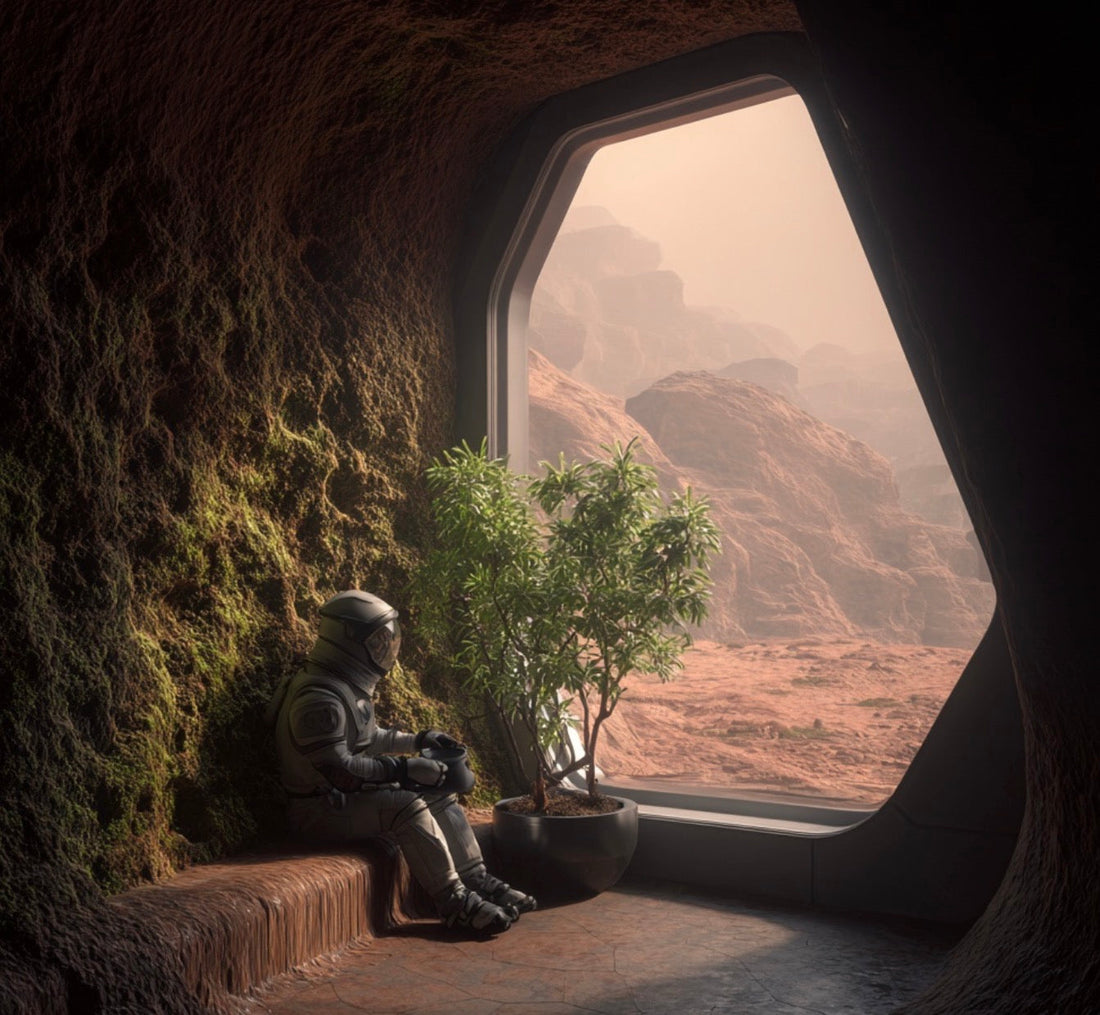
Space Fungi Frontier: Building Our Future Off-World, One Shroom at a Time
08/26/25Share
Table of Contents +
Article Summary
This article explores the cutting-edge field of myco-architecture, detailing how mycelium (the root structure of fungi) and agricultural waste are being used to grow sustainable, high-performance building materials for future habitats on the Moon and Mars.
The Space Fungi Frontier: A Guide to Myco-Architecture
Published on August 23, 2025
I. Introduction: The Concept of Myco-Architecture
Imagine a future Martian habitat with walls that are not metallic and sterile, but softly textured and organic. This is the vision of **myco-architecture**, a pioneering field that harnesses fungi to cultivate building materials directly in alien environments. Instead of launching heavy construction materials from Earth, this approach represents a profound shift towards biological, self-assembling systems for off-world living.
Supported by NASA's NIAC program, the "Mycotecture Off Planet" project is leading the charge, exploring how this living technology can provide sustainable solutions for habitats on the Moon and Mars. The core of **myco-architecture** is about growing structures, not just building them.
II. From Unwanted Guest to Essential Partner
Fungi's journey to space began inauspiciously. On the Mir space station, they were destructive stowaways, colonizing surfaces and even damaging windows. Yet, this demonstrated their incredible resilience. Certain fungi showed increased resistance to radiation, with some even appearing to convert it into energy. This resilience is a cornerstone of modern **myco-architecture**.
These early incidents revealed that the very organisms once seen as a threat could become potential saviors, capable of protecting us from the harsh realities of space.
III. The Blueprint for Myco-Architecture in Space
The central principle of **myco-architecture** is to grow habitats in-situ. The process involves sending dormant fungal spores, like those of the Red Reishi (*Ganoderma lucidum*), into space. Once hydrated with local water, these spores germinate and grow into robust structures, dramatically reducing logistical costs.

The mycelium—the root-like network of the fungus—is cultivated and then compressed into strong, interlocking hexagonal tiles. These tiles have shown strength comparable to wood and concrete and offer superior insulation, soundproofing, and fire resistance. This makes **myco-architecture** a versatile solution for everything from structural walls to radiation shielding and life support systems.
IV. Current Progress and Future Challenges
The excitement around **myco-architecture** is growing, with continued funding from NASA and interest from the ESA. On Earth, mycelium-based products are already demonstrating the material's versatility.

However, significant questions remain. Preventing contamination of extraterrestrial environments is a critical challenge, as is ensuring the long-term durability of a biodegradable material in the vacuum of space. Standardizing the growth process to achieve consistent material strength is another key hurdle for the field of **myco-architecture**.
V. Expanded FAQ: Your Myco-Architecture Questions
What exactly is myco-architecture? +
Myco-architecture is an emerging field of design and engineering that uses mycelium, the root structure of fungi, as a primary building material. The process involves growing the mycelium on a substrate of organic waste, which it binds together into a strong, lightweight, and sustainable composite material that can be shaped into bricks, panels, or other structural forms.
How is myco-architecture different from traditional space construction? +
The key difference is "growing" versus "hauling." Traditional methods rely on launching heavy, pre-fabricated materials from Earth, which is incredibly expensive. Myco-architecture focuses on in-situ resource utilization (ISRU) by transporting lightweight, dormant spores and growing the final, dense habitat on-site using local resources like water ice, thereby drastically reducing launch mass.
What are the main challenges for myco-architecture in space? +
The main challenges include: 1) Planetary Protection: Preventing the accidental contamination of Martian or lunar environments with Earth-based fungi. 2) Durability: Ensuring the material can withstand the vacuum of space and extreme temperature swings. 3) Consistency: Perfecting the growth process to produce materials with reliable and uniform strength.
Is myco-architecture safe for astronauts? +
Yes, the final material is safe. The process involves baking the grown mycelium, which renders it inert and stops any further growth or spore production. The resulting material is non-toxic and often free of the volatile organic compounds (VOCs) found in many synthetic materials, contributing to a healthier indoor environment for the crew.
How strong are buildings made from myco-architecture? +
Terrestrial tests have shown that compressed mycelium composites can be stronger than dimensional lumber and even rival the compressive strength of some forms of concrete. Further research is needed to confirm these properties in a space environment, but the initial results are very promising for **myco-architecture** applications.
Can mycelium really protect against space radiation? +
Yes, this is one of the most exciting aspects. Certain fungi, particularly those rich in melanin, have demonstrated a remarkable ability to absorb radiation. In fact, some fungi have been observed growing towards sources of radiation. Integrating these species into a myco-architecture habitat could provide a significant, self-sustaining layer of radiation shielding for astronauts.
What is the future of myco-architecture on Earth? +
The future on Earth is bright. We are already seeing myco-architecture used for sustainable packaging, insulation panels, acoustic tiles, furniture, and even art installations. As the technology becomes more scalable and cost-effective, it has the potential to become a mainstream green building material, reducing the construction industry's carbon footprint.
What happens to a mycelium building at the end of its life? +
Unlike concrete or plastic, a key benefit of myco-architecture is its biodegradability. On Earth, the material can be composted and returned to the soil. In space, the vision is for a fully circular system where old habitat materials can be broken down and used as feedstock to grow new structures, creating a truly regenerative building cycle.
Could a habitat made of myco-architecture repair itself? +
This is a long-term goal of the field. While the initial habitats would be made from inert (baked) mycelium, researchers are exploring "living" myco-architecture. This would involve embedding dormant spores within the material that could be activated with a nutrient gel to regrow and repair damaged sections, such as a micrometeoroid impact.
What is the "Mycotecture Off Planet" project? +
"Mycotecture Off Planet" is the official name of the research project funded by the NASA Innovative Advanced Concepts (NIAC) program. It is the primary initiative exploring the feasibility of using mycelium to grow habitats and other structures in space, focusing on developing the core technologies needed for successful **myco-architecture** beyond Earth.




